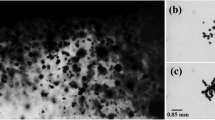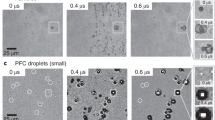Abstract
Acoustic cavitation—the formation and implosive collapse of bubbles—occurs when a liquid is exposed to intense sound. Cavitation can produce white noise, sonochemical reactions, erosion of hard materials, rupture of living cells and the emission of light, or sonoluminescence1,2. The concentration of energy during the collapse is enormous: the energy of an emitted photon can exceed the energy density of the sound field by about twelve orders of magnitude3, and it has long been predicted that the interior bubble temperature reaches thousands of degrees Kelvin during collapse. But experimental measurements4,5 of conditions inside cavitating bubbles are scarce, and there have been no studies of interior temperature as a function of experimental parameters. Here we use multi-bubble sonoluminescence from excited states of metal atoms as a spectroscopic probe of temperatures inside cavitating bubbles. The intense atomic emission allows us to change the properties of the gas–vapour mixture within the bubble, and thus vary the effective emission temperature for multi-bubble sonoluminescence from 5,100 to 2,300 K. We observe emission temperatures that are in accord with those expected from compressional heating during cavitation.
This is a preview of subscription content, access via your institution
Access options
Subscribe to this journal
Receive 51 print issues and online access
$199.00 per year
only $3.90 per issue
Buy this article
- Purchase on Springer Link
- Instant access to full article PDF
Prices may be subject to local taxes which are calculated during checkout





Similar content being viewed by others
References
Suslick,K. S. & Crum,L. A. in Handbook of Acoustics (ed. Crocker, M. J.) 243–253 (Wiley-Interscience, New York, 1998).
Knapp,R. T., Daily,J. W. & Hammitt,F. G. Cavitation (McGraw-Hill, New York, 1970).
Barber,B. P. & Putterman,S. J. Observation of synchronous picosecond sonoluminescence. Nature 352, 318–320 (1991).
Flint,E. B. & Suslick,K. S. The temperature of cavitation. Science 253, 1325–1326 (1991).
Suslick,K. S., Hammerton,D. A. & Cline, R. E. Jr Sonochemical hot spot. J. Am. Chem. Soc. 108, 5641–5642 (1986).
Suslick,K. S., Flint,E. B., Grinstaff,M. W. & Kemper,K. A. Sonoluminescence from metal carbonyls. J. Phys. Chem. 97, 3098–3099 (1993).
Alkemande,C. T. J., Hollander,T., Snelleman,W. & Zeegers,P. J. T. Metal Vapours in Flames (Pergamon, New York, 1982).
Wiese,W. L., Fuhr,J. R. & Martin,G. A. Atomic transition probabilities: scandium through manganese. J. Phys. Chem. Ref. Data 17, 311–327 (1988).
Wiese,W. L., Fuhr,J. R. & Martin,G. A. Atomic transition probabilities: iron through nickel. J. Phys. Chem. Ref. Data 14, 13–67 (1988).
Whaling,W. & Brault,J. W. Comprehensive transition probabilities in molybdenum I. Phys. Scr. 38, 707–715 (1988).
Gaydon,A. G. The Spectroscopy of Flames 2nd edn (Wiley, New York, 1974).
Cabannes,F. & Chapelle,J. in Reactions Under Plasma Conditions 1st edn Vol. 1 (ed. Venugopalan, M.) 367–470 (Wiley-Interscience, New York, 1971).
Reif,I., Fassel,V. A. & Kniseley,R. N. Spectroscopic flame measurements and their physical significance I: theoretical concepts. Spectrochim. Acta B 28, 105–123 (1973).
Jeffries,J. B., Copeland,R. A., Suslick,K. S. & Flint,E. B. Thermal equilibration during cavitation. Science 256, 248 (1992).
Noltingk,B. E. & Neppiras,E. Cavitation produced by ultrasonics. Proc. Phys. Soc. B 63, 674–685 (1950).
Kamath,V., Prosperetti,A. & Egolfopoulos,F. N. A theoretical study of sonoluminescence. J. Acoust. Soc. Am. 94, 248–260 (1993).
Jarman,P. Measurements of sonoluminescence from pure liquids and some aqueous solutions. Proc. Phys. Soc. 73, 628–640 (1959).
Flint,E. B. & Suslick,K. S. Sonoluminescence from nonaqueous liquids: emissions from small molecules. J. Am. Chem. Soc. 111, 6987–6992 (1989).
Suslick,K. S. & Flint,E. B. Sonoluminescence of alkali metal salts. J. Phys. Chem. 95, 1484–1488 (1991).
Suslick,K. S., Gawienowski,J. J., Schubert,P. F. & Wang,H. H. Alkane sonochemistry. J. Phys. Chem. 87, 2299–2301 (1983).
Suslick,K. S., Gawienowski,J. W., Schubert,P. F. & Wang,H. H. Sonochemistry in non-aqueous liquids. Ultrasonics 22, 33–36 (1984).
Yaws,C. L. Handbook of Vapor Pressures Vol. 3, 383 (Gulf, Houston, 1994).
Hickling,R. Effects of thermal conduction in sonoluminescence. J. Acoust. Soc. Am. 35, 967–974 (1963).
Young,F. R. Sonoluminescence from water containing dissolved gases. J. Acoust. Soc. Am. 60, 100–104 (1976).
Yasui,K. J. Phys. Soc. Jpn 65, 2830–2840 (1996).
Suslick,K. S. & Flint,E. B. Sonoluminescence of non-aqueous liquids. Nature 330, 553–555 (1987).
Zel'dovich,Y. D. & Raizer,Y. P. Physics of Shock Waves and High Temperature Hydrodynamic Phenomenon 2nd edn (Academic, New York, 1966).
Acknowledgements
This work was supported by the US National Science Foundation, the US Department of Energy, and in part by the US Defence Advanced Research Projects Agency.
Author information
Authors and Affiliations
Corresponding author
Rights and permissions
About this article
Cite this article
McNamara, W., Didenko, Y. & Suslick, K. Sonoluminescence temperatures during multi-bubble cavitation. Nature 401, 772–775 (1999). https://doi.org/10.1038/44536
Received:
Accepted:
Issue Date:
DOI: https://doi.org/10.1038/44536
This article is cited by
-
Degradation of ammonia nitrogen by an economic combined hydrodynamic cavitation method
Environmental Science and Pollution Research (2023)
-
Impact of dissolved rare gases (Ar, Xe and He) on single-bubble sonochemistry in the presence of carbon tetrachloride
Chemical Papers (2022)
-
Ultrasonic-assisted organic–inorganic multilayer thin film synthesis and enhanced visible-light phototropy based on PVP /PMoA
Journal of Materials Science (2021)
-
Sonochemically synthesized Ni-doped ZnS nanoparticles: structural, optical, and photocatalytic properties
Journal of Materials Science: Materials in Electronics (2020)
-
Parameters Influencing Cavitation Within Vials Subjected to Drop Shock
Scientific Reports (2019)
Comments
By submitting a comment you agree to abide by our Terms and Community Guidelines. If you find something abusive or that does not comply with our terms or guidelines please flag it as inappropriate.



